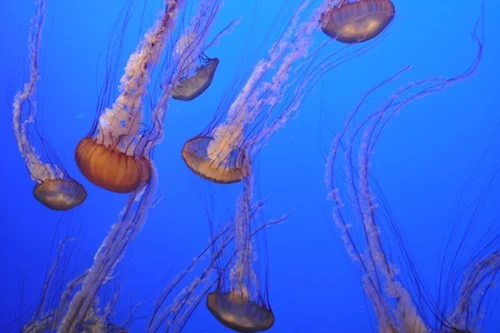Jellyfish are not fish.
There are different kinds and sizes of jellyfish.
Jellyfish are made mostly of water.
They don't have heart, brain or bones.
Jellyfish live in all of the world's oceans.
Lions mane jellyfish, the largest jellyfish. ©Getty Images
What are jellyfish?
Jellyfish are simple invertebrates (animals with no backbone). They are part of a family called cnidarians (say nigh-dare-ree-uns), animals that are made of a substance that looks like gelatine. Jellyfish have been in the oceans for over 650 million years. That's from before the dinosaurs!
There are thousands of different kinds of jellyfish, in sizes ranging from those as tiny as your fingertip to some with a 4 metre body and 60 metre tentacles. Most are known as 'true jellyfish' and are not harmful to people.
At various times, many hundreds of jellyfish gather in a vast group. This is called a 'bloom'.
A bloom of jellyfish. ©Getty Images
Habitat and distribution (where they are found)
Their habitat is both warm and cold oceans, in deep water as well as in shallow water along coastlines.
Bodies and movement
Jellyfish bodies don't have a left and right like the bodies of many other animals such as mammals, fish, reptiles and so on. Their body is a sort of bell shape, with dangling tentacles that are like feeding arms. They are about 95% water.
Their bodies have three layers:
the epidermis, an outer layer;
a middle layer of mesoglea, which is a thick jelly like substance;
a gastrodermis, the inner layer.
Jellyfish have a simple digestive cavity that is mouth and stomach and intestine so it takes in food and lets out waste. They have nerve nets instead of brains. These sense changes in the surroundings and help the animal respond.
Rose jellyfish. Image©kidcyber
Jelly fish move by a kind of jet propulsion. They expand and then quickly contract the bell-shaped body – think of opening and closing an umbrella quickly. This movement forces water away from the bell and pushes the animal in the opposite direction.
Some jellyfish are clear, while others are very colourful. Some even glow in the dark, which may distract predators, but it may also attract prey.
If a piece of its body breaks off, it can develop into a whole jellyfish.
Diet of jellyfish
Their diet is fish, shrimps and tiny plants. The tentacles have tiny stinging parts so that if prey brushes against them, they are injected with venom so they can't move. The tentacles move the prey into the cavity for digestion. Jellyfish digest their food quickly because large amounts of digesting food would hamper their ability to float.
The venom in the tentacles of box jellyfish is dangerous, often fatal, to humans.
Life Cycle of jellyfish
An adult is called a medusa. It releases into the water both eggs and sperm, which forms a planula, which is a larva stage.
Large black sea nettle jellyfish. Its sting is painful to humans but not lethal. ©Getty Images
The planula hooks onto a rock and grows into the next stage, which is a polyp, resembling a sea anemone. It can stay at this stage for months or even years. When the polyp buds, it is the next stage, called strobila. This causes it to change into the next stage, which is called ephyra, and which grows into an adult medusa.
Box jellyfish
There is a group of about 20 called cubozoa, or box jellyfish, named for their cube-shaped body. They are also called sea wasps and marine stingers. Their average life span is less than a year.
The most dangerous box jellyfish are found near the shores of the northern and north-eastern Australia. Box jellyfish have been seen off the coasts of Japan, California, Vietnam, the Philippines and Hawaii.
The box jellyfish can move rather than drift. They can weigh up to 2 kilograms. The bell, which is the body, can measure 20 centimetres across and be up to 30 centimetres long. The bell is pale blue or milky white, but in the water it is transparent and almost invisible. They have 24 eyes in groups of 6 all around their bell.
Box jellyfish can have up to 60 tentacles, in four bundles. The tentacles stretch out 2 -3 metres. Some of the tentacles contain many millions of stinging cells. The stinging cells fire venomous darts into the skin of prey that is touched by the tentacles. Other tentacles contain a sticky fluid. These tentacles cling onto things and sense whether they are living or non-living.
Where they live
Box jellyfish feed on shrimps and other small sea creatures, which they catch and kill with their venomous tentacles. They then drag their prey into the bell to be eaten.
Box jellyfish stings
A person who comes into contact with a box jellyfish will feel strong pain. They might also find it difficult to speak or breathe. The venom enters the bloodstream and attacks the heart and nerves. People have died from box jellyfish stings! But, fortunately there is an anti venom for the stings. People stung should seek medical help immediately!
A group of box jellyfish. ©Getty Images
Read about the life cycle of jellyfish and see a diagram
http://www.teara.govt.nz/en/diagram/5355/jellyfish-life-cycle







